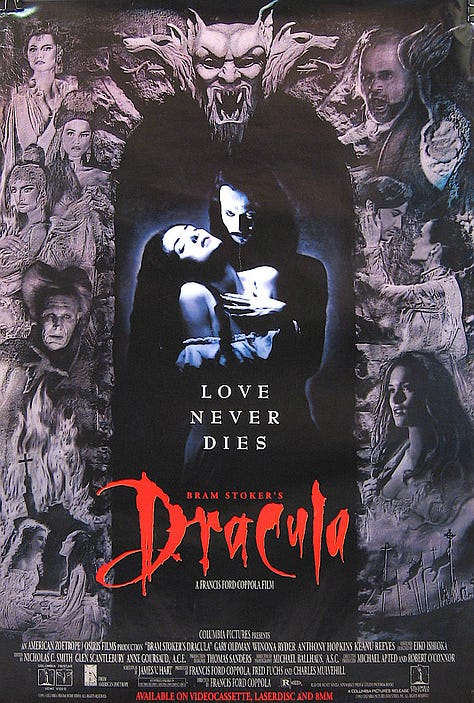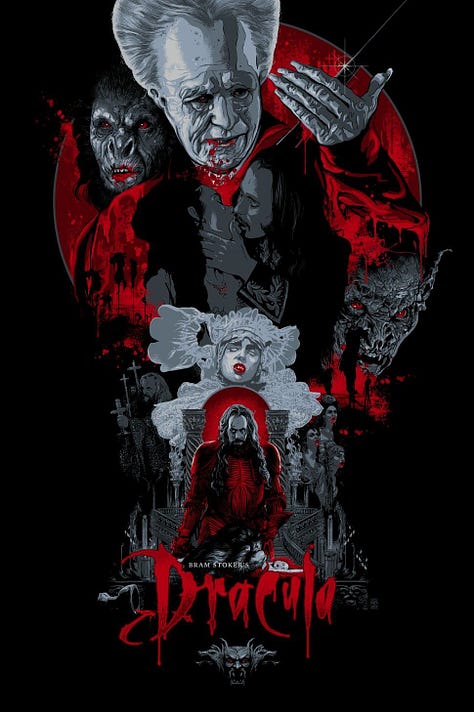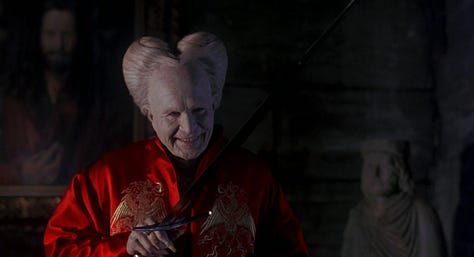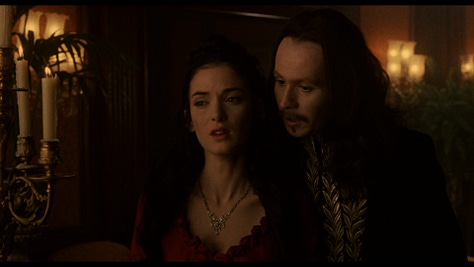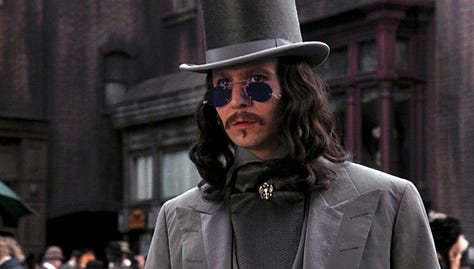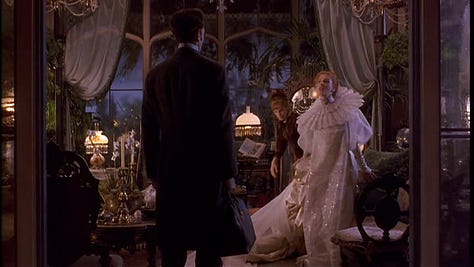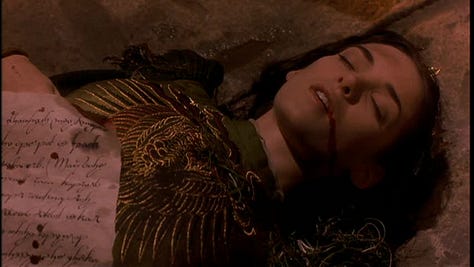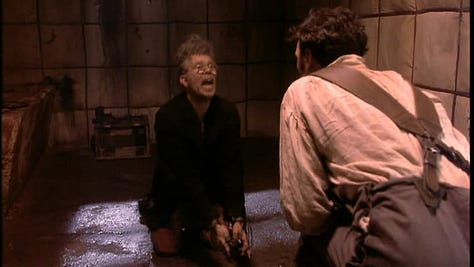BRAM STOKER’S DRACULA
1992 • Francis Ford CoppolaScreenplay: James V. Hart; Based on Dracula by Bram Stoker
Cast: Gary Oldman, Winona Ryder, Anthony Hopkins, Keanu Reeves, Richard E. Grant, Cary Elwes, Billy Campbell, Sadie Frost, Tom Waits, Jay Robinson
Cinematography: Michael Ballhaus
Music: Wojciech Kilar
Producer: Francis Ford Coppola, Fred Fuchs, Charles Mulvehill
Columbia Pictures
I have crossed oceans of time to find you.
In the many adaptations of the most famous vampire novel of all time, Bram Stoker's Dracula may be my personal favorite. The story is familiar: Jonathan Harker (Keanu Reeves) travels to Transylvania to assist the enigmatic Count Dracula (Gary Oldman in a remarkable performance) in a real estate transaction in England. Upon arriving at Dracula's castle, Harker is imprisoned and gradually realizes that he is a prisoner of the undead Count. Dracula travels to England, where he becomes obsessed with Harker's fiancée, Mina Murray, and her friend Lucy Westenra. As Dracula preys upon Lucy, her deteriorating health and strange behavior baffle her friends and family. Professor Abraham Van Helsing (Anthony Hopkins), joins forces with Lucy's fiancé, Arthur Holmwood, Dr. Jack Seward, and American cowboy Quincey P. Morris to combat the ancient evil that Dracula represents.
I’m going to get this out of the way because I know you’re thinking it. Keanu’s English accent. Yes. It’s bad. Yes, he was probably miscast. Certainly, it has been a point of discussion among viewers and critics. This minor flaw doesn't significantly diminish the overall quality of the movie. Reeves himself has acknowledged his struggle with the accent. However, the brilliance of the film lies in its storytelling, opulent visuals, and the stellar performances of the rest of the cast. So, let’s put this to bed, or perhaps put a stake through its heart because there’s so much to admire about this film.
Francis Ford Coppola's adaptation of Bram Stoker's iconic novel Bram Stoker's Dracula stands as a magnum opus in the realm of vampire cinema. With meticulous attention to detail, Coppola crafts a visually stunning and psychologically rich narrative that delves into the very essence of the vampire mythos. His interpretation goes beyond mere horror, exploring love, obsession, and the eternal struggle between light and darkness. One of the notable aspects of Coppola's rendition is his dedication to Stoker's original vision while infusing the story with his own distinct style. He resurrects the Gothic atmosphere of 19th-century Eastern Europe and Victorian England, meticulously recreating the settings with ornate costumes, grandiose castles, and eerie landscapes. This attention to historical and visual style transports the audience to a long-gone era, immersing them in the decadent and shadowy world where Dracula's dark influence looms large.
This film is a veritable feast for the eyes, with its gorgeous cinematography serving as a visual symphony from the very first frame. The cinematographic brilliance in Bram Stoker's Dracula is evident in every scene, with each frame meticulously composed to evoke a specific emotion or atmosphere. It is, by far, the most beautifully filmed adaptation of Dracula of all time. The rich, deep colors and lighting create a sense of Gothic grandeur, immersing the viewers in the opulence of the 19th century. The juxtaposition of light and shadow, masterfully employed by cinematographer Michael Ballhaus, casts an eerie and haunting ambiance, perfectly complementing the film's exploration of darkness and desire. The camera movements gloriously enhance the film's aesthetic.
Every scene is a visual spectacle. The art direction brings to life the elaborate and haunting world of the 19th century. From the grandeur of Dracula's castle in Transylvania to the Victorian elegance of Lucy Westenra's home in England, to Dr. Seward’s haunting insane asylum, every set is meticulously crafted with intricate details. The use of Gothic architectural elements, ornate furniture, and macabre decorative accents creates an atmosphere that is both opulent and eerie, capturing the essence of Stoker's novel and the Victorian era.
Equally impressive are the costumes, designed with unparalleled creativity and historical accuracy, with each stitch and texture brilliantly illuminated on the screen. Francis Ford Coppola's meticulous approach shines through in his methods of preparation and creative direction. His decision to allocate a significant portion of the budget to costumes demonstrates his understanding of the vital role attire plays in character portrayal. By considering the actors as the "jewels" of the film, Coppola highlighted his focus on bringing their characters to life through visually stunning clothing. He instructed his designers: "'Give me something that either comes from the research or that comes from your own nightmares.” By encouraging creativity, he fostered an environment where artists could push boundaries and explore unconventional ideas. This departure from formulaic approaches resulted in a film that was not only visually unique but also artistically daring. The characters are clothed in exquisite garments that reflect their personalities and the time period. Count Dracula's attire, for instance, evolves throughout the film, mirroring his transformation from a centuries-old vampire into a charismatic nobleman. Moreover, the costumes play a crucial role in character development. Mina Murray's dresses, ranging from innocent whites to seductive reds, mirror her transition from purity to temptation under Dracula's influence. Lucy Westenra's costumes, on the other hand, exude youthful exuberance and sensuality, emphasizing her vulnerability to the supernatural forces around her.
Moreover, the film's visual effects and practical makeup are nothing short of extraordinary, setting new standards for cinematic artistry. The seamless integration of practical effects and digital wizardry brought to life the supernatural elements of the story with a level of sophistication rarely seen before. The majority of special effects were achieved in-camera, showcasing Coppola’s dedication to practical craftsmanship. The decision to employ in-camera effects not only demonstrated the team's technical expertise but also added a visceral quality to the film, grounding its fantastical elements in a tangible reality that continues to captivate viewers. The meticulous attention to detail in these effects elevated the film, creating a sense of immersion that drew audiences deeper into the dark and seductive world of Dracula.
Additionally, Bram Stoker's Dracula stands as a testament to the artistry of practical makeup, particularly evident in the aging and de-aging of Gary Oldman's character, Dracula. The makeup artists' extraordinary talent is evident as they skillfully transform Oldman, allowing him to seamlessly portray the various stages of Dracula's centuries-long existence. Through meticulous attention to detail and a deep understanding of their craft, the makeup artists contributed significantly to the film's immersive experience.
Gary Oldman's portrayal of Dracula is nothing short of mesmerizing. Oldman's decision to take on the role based on the iconic line "I have crossed oceans of time to find you" speaks to his understanding of the character's depth and complexity. In his hands, Dracula transforms from a mere bloodsucking monster into a multifaceted being haunted by centuries of love and loss. Oldman's Dracula is more than just a fearsome predator; he becomes a tragic figure, a romantic soul burdened by the weight of immortality and the eternal search for his lost love. Coppola's direction, coupled with Oldman's nuanced performance, humanizes the vampire king in a way that goes beyond traditional horror tropes. Dracula's seductive charm and vulnerability make him a captivating lover, while his predatory nature adds a chilling layer to his character. This duality, brilliantly portrayed by Oldman, explores the intricacies of human emotions and desires, delving into the eternal struggle between the darkness within and the longing for connection. In essence, the film transcends its horror roots and evolves into a profound exploration of the forbidden, showcasing the magnetic pull of passion and the complexities of the human heart. Oldman's Dracula becomes a symbol of the eternal conflict between love and desire, fear and fascination.
The supporting cast complements the film's overall brilliance, adding depth and dimension to the narrative. Winona Ryder, in her role as Mina Murray, brings a charming vulnerability to the screen. Her portrayal is a delicate balance of innocence and strength, making her character endearing and relatable. Ryder captures Mina's internal conflict and emotional turmoil with grace, allowing the audience to empathize with her as she becomes entangled in the supernatural web spun by Dracula. Anthony Hopkins, portraying Professor Abraham Van Helsing, injects the film with theatrical energy, hamming it up and making a meal of every line. Hopkins' performance is a delightful blend of wisdom and eccentricity, infusing Van Helsing with a charismatic quirkiness that makes him both entertaining and compelling. His theatricality adds a touch of humor to the film, balancing the darker themes with moments of levity.
Coppola's directorial prowess shines through in his ability to balance the film's sensuality and horror. In the realm of sensuality, Coppola's direction is marked by a lush and opulent visual style. Every frame of the film exudes a seductive allure, from the sumptuous costumes that drape the characters to the ornate sets that envelop them. The sensuality is not merely limited to the physical, as Coppola skillfully explores the emotional and psychological depths of his characters. He captures the forbidden desires and hidden passions of the protagonists, especially Dracula, with a delicate touch, allowing the audience to feel the intensity of their emotions. Through exquisite cinematography and evocative lighting, he infuses even the darkest moments with a sensuous undertone, drawing viewers into the intricate web of desire woven throughout the story.
Simultaneously, Coppola adeptly handles the horror elements, infusing the film with a palpable sense of dread and fear. His meticulous attention to pacing and tension-building techniques create an atmosphere of suspense that permeates every scene. The film's horror is not solely reliant on jump scares or graphic imagery; instead, Coppola relies on psychological horror, allowing the audience's imagination to fill in the gaps, making the terror more profound and unsettling. By seamlessly weaving these elements together, he creates a film that is as intellectually stimulating as it is emotionally resonant, leaving a lasting impact on the audience and solidifying his reputation as a visionary director in the realm of Gothic cinema.
Wojciech Kilar's musical composition serves as the film's heartbeat. His score masterfully captures the Gothic essence of the story, enhancing moments of romance with lush, sweeping melodies and intensifying scenes of horror with ominous, discordant tones. The music elicits a wide range of emotions from the audience, from heart-pounding fear to poignant sadness. Annie Lennox's "Love Song for a Vampire," which serves as the film's end-credit song, complements Kilar's score perfectly. Lennox's haunting vocals and the song's melancholic lyrics evoke a sense of tragic romance, mirroring the themes of eternal love and loss depicted in the film. It encapsulates the bittersweet essence of the Dracula legend.
If all that isn’t enough to convince you that Keanu Reeve’s miscasting is just a small part of an overall amazing film, then I renounce you. I shall rise from my own death, to avenge this film with all the powers of darkness!
I am the monster that breathing men would kill. I am Dracula.
Notoable Awards & Accomplishments
Academy Award Winner: Best Costume Design
Academy Award Winner: Best Makeup
Academy Award Winner: Best Sound Editing
Streaming: Pluto TV
Digital Rental/Purchase: Available at most major digital retailers
Physical Media: Available on 4K, Blu-Ray and DVD.

